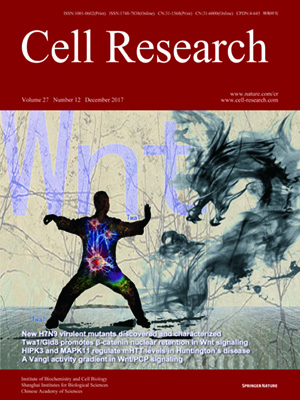
Volume 27, No 12, Dec 2017
ISSN: 1001-0602
EISSN: 1748-7838 2018
impact factor 17.848*
(Clarivate Analytics, 2019)
Volume 27 Issue 12, December 2017: 1466-1484
ORIGINAL ARTICLES
Wnt-induced Vangl2 phosphorylation is dose-dependently required for planar cell polarity in mammalian development
Wei Yang1, Lisa Garrett2, Di Feng1, Gene Elliott2, Xilin Liu2,3, Ni Wang1, Yu Ming Wong1, Nga Ting Choi1, Yingzi Yang2,4 and Bo Gao1,2,5
1School of Biomedical Sciences, Li Ka Shing Faculty of Medicine, The University of Hong Kong, 21 Sassoon Road, Pokfulam, Hong Kong, China
2National Human Genome Research Institute, National Institutes of Health, Bethesda, MD 20892, USA
3China-Japan Union Hospital of Jilin University, Changchun, Jilin 130033, China
4Department of Developmental Biology, Harvard School of Dental Medicine, 188 Longwood Ave., Boston, MA 02115, USA
5Centre for Reproduction, Development and Growth & HKU-SUSTEC Joint Laboratories of Matrix Biology and Diseases, The University of Hong Kong, Pokfulam, Hong Kong, China
Correspondence: Yingzi Yang, Tel: +1-617-432-8304; Fax: +1-617-432-3246 E-mail: yingzi_yang@hsdm.harvard.edu; Bo Gao, Tel: +852 3917-6809; Fax: +852 2855-1254(gaobo@hku.hk)
Planar cell polarity (PCP) is an evolutionarily conserved essential mechanism that provides directional information to control and coordinate polarized cellular and tissue behavior during embryonic development. Disruption of PCP leads to severe morphological defects in vertebrates and its dysregulation results in a variety of human diseases such as neural tube defects and skeletal dysplasia. PCP is governed by a set of highly conserved core proteins that are asymmetrically localized at the cell surface throughout the polarized tissues. The uniform directionality of PCP is established by global cues, such as Wg/Wnt signaling gradients that break the original symmetrical localization of core PCP proteins including Vang/Vangl and Fz/Fzd. However, the exact mechanism remains elusive. In this study, we found that Vangl2 phosphorylation, which was previously identified to be induced by Wnt5a signaling, is required for Vangl2 functions in mammalian PCP in multiple tissues. The in vivo activities of Vangl2 are determined by its phosphorylation level. Phospho-mutant Vangl2 exhibits dominant negative effects, whereas Vangl2 with reduced phosphorylation is hypomorphic. We show that Vangl2 phosphorylation is essential for its uniform polarization pattern. Moreover, serine/threonine kinases CK1ε and CK1δ are redundantly required for Wnt5a-induced Vangl2 phosphorylation. Dvl family members are also required for Wnt5a-induced Vangl2 phosphorylation by enhancing the interaction of CK1 and Vangl2. These findings demonstrate that induction of Vangl protein phosphorylation plays an essential role in transducing Wnt5a signaling to establish PCP in mammalian development, suggesting a phosphorylation-regulated “Vangl activity gradient” model in addition to the well-documented “Fz activity gradient” model in Wnt/PCP signaling.
10.1038/cr.2017.127
FULL TEXT | PDF
Browse 1630


